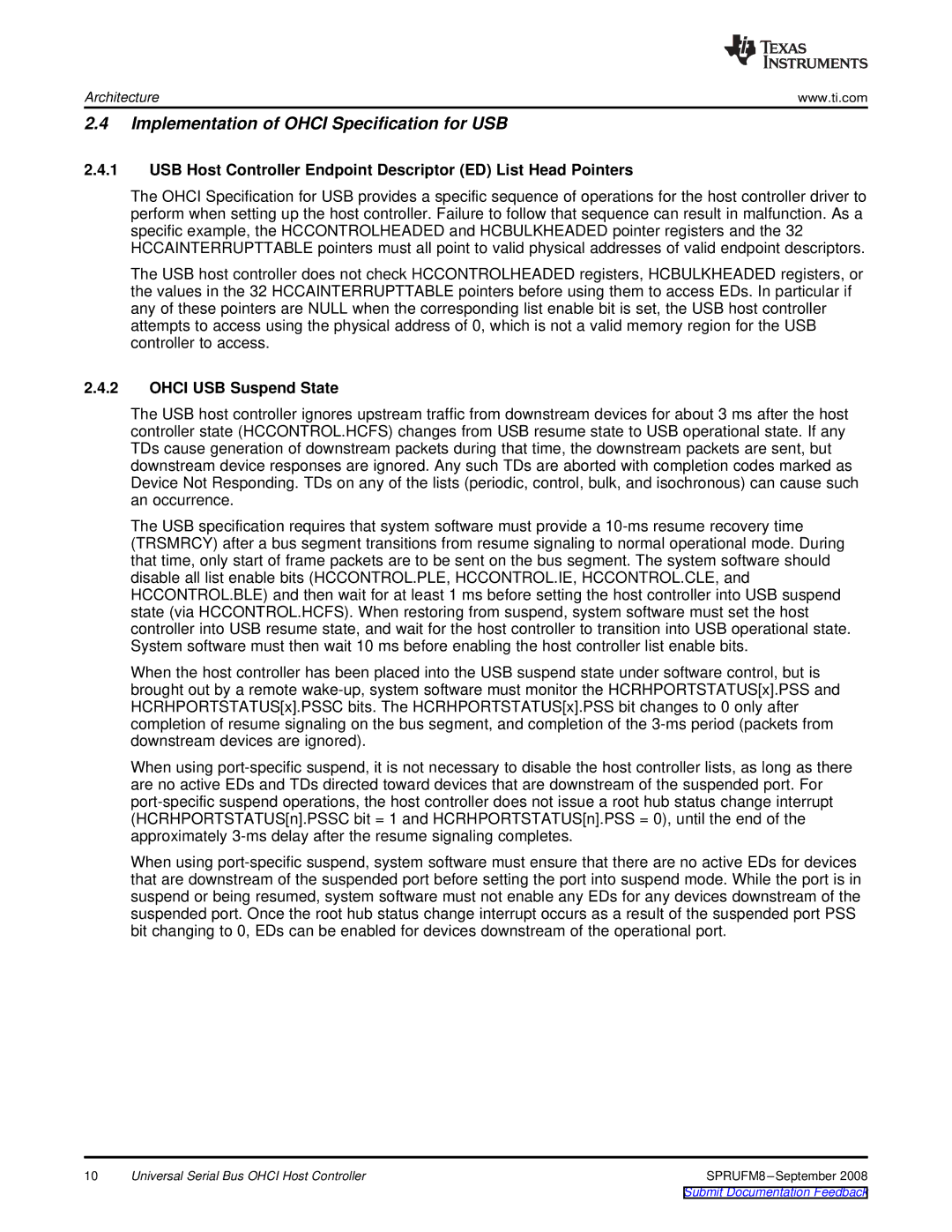2.4Implementation of OHCI Specification for USB
2.4.1USB Host Controller Endpoint Descriptor (ED) List Head Pointers
The OHCI Specification for USB provides a specific sequence of operations for the host controller driver to perform when setting up the host controller. Failure to follow that sequence can result in malfunction. As a specific example, the HCCONTROLHEADED and HCBULKHEADED pointer registers and the 32 HCCAINTERRUPTTABLE pointers must all point to valid physical addresses of valid endpoint descriptors.
The USB host controller does not check HCCONTROLHEADED registers, HCBULKHEADED registers, or the values in the 32 HCCAINTERRUPTTABLE pointers before using them to access EDs. In particular if any of these pointers are NULL when the corresponding list enable bit is set, the USB host controller attempts to access using the physical address of 0, which is not a valid memory region for the USB controller to access.
2.4.2OHCI USB Suspend State
The USB host controller ignores upstream traffic from downstream devices for about 3 ms after the host controller state (HCCONTROL.HCFS) changes from USB resume state to USB operational state. If any TDs cause generation of downstream packets during that time, the downstream packets are sent, but downstream device responses are ignored. Any such TDs are aborted with completion codes marked as Device Not Responding. TDs on any of the lists (periodic, control, bulk, and isochronous) can cause such an occurrence.
The USB specification requires that system software must provide a 10-ms resume recovery time (TRSMRCY) after a bus segment transitions from resume signaling to normal operational mode. During that time, only start of frame packets are to be sent on the bus segment. The system software should disable all list enable bits (HCCONTROL.PLE, HCCONTROL.IE, HCCONTROL.CLE, and HCCONTROL.BLE) and then wait for at least 1 ms before setting the host controller into USB suspend state (via HCCONTROL.HCFS). When restoring from suspend, system software must set the host controller into USB resume state, and wait for the host controller to transition into USB operational state. System software must then wait 10 ms before enabling the host controller list enable bits.
When the host controller has been placed into the USB suspend state under software control, but is brought out by a remote wake-up, system software must monitor the HCRHPORTSTATUS[x].PSS and HCRHPORTSTATUS[x].PSSC bits. The HCRHPORTSTATUS[x].PSS bit changes to 0 only after completion of resume signaling on the bus segment, and completion of the 3-ms period (packets from downstream devices are ignored).
When using port-specific suspend, it is not necessary to disable the host controller lists, as long as there are no active EDs and TDs directed toward devices that are downstream of the suspended port. For port-specific suspend operations, the host controller does not issue a root hub status change interrupt (HCRHPORTSTATUS[n].PSSC bit = 1 and HCRHPORTSTATUS[n].PSS = 0), until the end of the approximately 3-ms delay after the resume signaling completes.
When using port-specific suspend, system software must ensure that there are no active EDs for devices that are downstream of the suspended port before setting the port into suspend mode. While the port is in suspend or being resumed, system software must not enable any EDs for any devices downstream of the suspended port. Once the root hub status change interrupt occurs as a result of the suspended port PSS bit changing to 0, EDs can be enabled for devices downstream of the operational port.
10 | Universal Serial Bus OHCI Host Controller | SPRUFM8–September 2008 |

